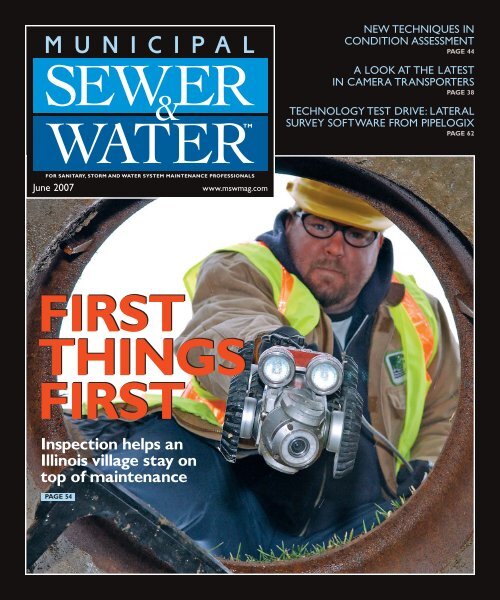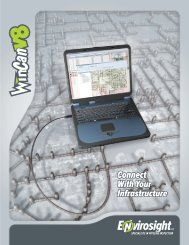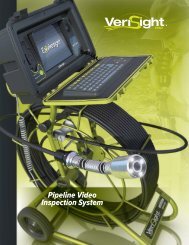WATER SEWER
Bolingbrook Profile M0607 - Envirosight
Bolingbrook Profile M0607 - Envirosight
- No tags were found...
You also want an ePaper? Increase the reach of your titles
YUMPU automatically turns print PDFs into web optimized ePapers that Google loves.
MUNICIPAL<br />
<strong>SEWER</strong><br />
&<br />
<strong>WATER</strong><br />
TM<br />
NEW TECHNIQUES IN<br />
CONDITION ASSESSMENT<br />
PAGE 44<br />
A LOOK AT THE LATEST<br />
IN CAMERA TRANSPORTERS<br />
PAGE 38<br />
TECHNOLOGY TEST DRIVE: LATERAL<br />
SURVEY SOFTWARE FROM PIPELOGIX<br />
PAGE 62<br />
FOR SANITARY, STORM AND <strong>WATER</strong> SYSTEM MAINTENANCE PROFESSIONALS<br />
June 2007<br />
www.mswmag.com<br />
FIRST<br />
THINGS<br />
FIRST<br />
Inspection helps an<br />
Illinois village stay on<br />
top of maintenance<br />
PAGE 54
FOCUS:<strong>SEWER</strong><br />
FIRST<br />
THINGS<br />
FIRST<br />
CCTV inspection technology helps a fast-growing<br />
Illinois village set correct priorities in maintaining<br />
and fixing 250 miles of sanitary sewer<br />
By Angus W. Stocking<br />
T<br />
he sewer inspection program<br />
in Bolingbrook, Ill.,<br />
is less than four years old.<br />
Yet it already is saving the<br />
village money “by concentrating<br />
on problem areas, and not overmaintaining<br />
in other areas,” according<br />
to Tony Torres, director of operations<br />
in the Public Works Department.<br />
“We’re able to concentrate efforts<br />
where they’re needed.”<br />
This kind of discriminating care is<br />
needed. Bolingbrook is in Will County,<br />
the fastest-growing community in the<br />
Chicago area. The village has more<br />
than 250 miles of sanitary sewer and<br />
330 miles of storm sewer, some of it<br />
dating back 40 years or more. And a<br />
fairly high percentage was installed<br />
without proper underlay or backfill.<br />
That means recurring problems with<br />
shifting, heaving, and separated joints.<br />
Torres stays ahead of the game by<br />
investing in high-quality CCTV pipe<br />
inspection equipment, and by training<br />
Bolingbrook technicians view<br />
a sewer line inspection being<br />
performed by a ROVVER<br />
camera from Envirosight LLC.<br />
(Photography by Dave Kenik)<br />
his staff to think ahead. “We’re a bit<br />
ahead of the curve because we’re proactive<br />
rather than reactive,” he says. “A lot<br />
of credit goes to our workers, because<br />
they’re the ones who are out there<br />
identifying problems and coming up<br />
with solutions.”<br />
Good vision<br />
On a previous job, Torres implemented<br />
the inspection program in<br />
Joliet, Ill., and he helped acquire<br />
that city’s first CCTV unit, a ROVVER<br />
camera system from Envirosight LLC.<br />
When he came to Bolingbrook, he<br />
acquired the same unit for the village (a<br />
Model 125) because he liked its flexibility<br />
and ease of control.<br />
“I think the zoom is a nice feature,<br />
as well as the lighting,” he says. “The<br />
steering lets us maneuver the camera in<br />
large pipes, and it’s nice to be able to<br />
control the speed in forward or<br />
reverse.” End users in the new department<br />
were involved in field tests before<br />
the purchase, and they unanimously<br />
approved the technology.<br />
Repairing blockages and other failures<br />
took much longer before the<br />
CCTV purchase. It often took four-man<br />
crews up to a day to dig up the pipe,<br />
find the blockage area, repair the pipe,<br />
and then backfill. And because it was<br />
easy to miss nearby problems, crews<br />
were often back in the same areas<br />
within a month.<br />
“Because it was open trenching,”<br />
says Torres, “there was no<br />
way of seeing what the<br />
PROFILE:<br />
Village of<br />
Bolingbrook, Ill.<br />
INCORPORATED:<br />
1965<br />
POPULATION:<br />
72,000<br />
AREA:<br />
21 square miles<br />
INFRASTRUCTURE:<br />
250 miles of sanitary sewer<br />
WEB SITE:<br />
www.bolingbrook.com
MODULAR<br />
SYSTEM<br />
“We’re a bit ahead of the curve because we’re proactive<br />
rather than reactive. A lot of credit goes to our workers,<br />
because they’re the ones who are out there identifying<br />
problems and coming up with solutions.”<br />
obstruction was. It could have been<br />
an improper connection, a stab in<br />
(improperly connected service lateral),<br />
roots, grease, or a broken pipe. We just<br />
didn’t know. Now we can see what we’re<br />
dealing with.”<br />
Tough situations<br />
One recent repair provides an<br />
example of the new approach. “We ran<br />
into a situation where a customer kept<br />
getting backups,” Torres says. “After<br />
TVing the sanitary main, we found a<br />
large root mass in the lateral. Attempts<br />
to remove the roots were unsuccessful,<br />
so in this case we did open up a trench.<br />
We found roots in the pipe so thick that<br />
they looked like a beaver pelt.<br />
“We ended up having to re-pipe. But<br />
even with all that extra work, we were<br />
able to locate the blockage, then<br />
trench, repair and backfill, all in about<br />
five hours. Having the camera took the<br />
guessing out of it. Not to mention that<br />
we might have missed the lateral blockage<br />
without it.”<br />
Torres doesn’t record every foot of<br />
inspected pipe. “We don’t shoot everything;<br />
we’re able to take still shots or<br />
video of just the problem areas and<br />
record them,” he says. “Then we can log<br />
them into a work order.” And after a<br />
problem is fixed, the department usually<br />
Tony Torres<br />
inspects the surrounding neighborhoods<br />
thoroughly, hoping to identify<br />
and resolve problems before service is<br />
disrupted. Likewise, after emergency<br />
callouts, crews thoroughly inspect all<br />
nearby lines.<br />
Torres likes CCTV so much that<br />
he’ll soon expand the department’s<br />
options. The department is looking at<br />
a QuickView portable zoom survey<br />
camera from Envirosight for inspecting<br />
manholes and other confined spaces.<br />
“It will have zoom and lighting capability<br />
and will capture video and still<br />
images,” Torres says. “It’s also submersible.”<br />
Part of the reason for the<br />
pole camera is speed and convenience,<br />
but another big factor is safety: “We<br />
wanted to minimize confined-space<br />
entries to make things safer for our<br />
workers.”<br />
To complement the CCTV unit,<br />
Bolingbrook also operates two Vactor<br />
2100 Series jetter/vacuum combination<br />
trucks with 10-cubic-yard debris tanks.<br />
Off to a good start<br />
There are five employees in the<br />
sanitary sewer inspection department,<br />
and several employees in the National<br />
Pollutant Discharge Elimination System<br />
(NPDES) department are cross-trained<br />
for storm sewer inspection. Eight<br />
The camera is deployed for an<br />
inspection on an off-street right-ofway.<br />
employees are trained to operate the<br />
CCTV camera in two-man crews. To<br />
minimize reliance on contractors and<br />
increase confidence on jobsites,<br />
Bolingbrook has two employees performing<br />
locates.<br />
Torres generally avoids subcontracting,<br />
preferring to keep as much work as<br />
possible in-house to save money and<br />
develop experience in his team. But he<br />
does feel that the inflow and infiltration<br />
The camera and<br />
crawler are seen<br />
from above as the<br />
crawler starts<br />
into a pipe.<br />
The ROVVER line of robotic<br />
crawlers from Envirosight LLC is<br />
designed for versatility. Modular<br />
design allows interchange of<br />
cameras, control units, cable<br />
reels and lighting, so that the<br />
unit can be used in pipes of<br />
varying size.<br />
Cameras are fully directional,<br />
meaning that they can zoom,<br />
pan, tilt and refocus as needed.<br />
These steerable crawlers are<br />
valuable in large-diameter pipes,<br />
since they enable operators to<br />
avoid obstructions and inspect<br />
laterals. The crawlers are also<br />
all-wheel-drive, with several<br />
speeds in forward and reverse.<br />
The QuickView pole camera<br />
is designed as a simple inspection<br />
system with a zoom camera<br />
and lights. It is used to look<br />
as far as 250 feet down large<br />
diameter lines. Users can quickly<br />
inspect pipes and enclosed<br />
spaces without worry about<br />
confined-space hazards.<br />
For information: 973/252-<br />
6700; www.envirosight.com.
A Bolingbrook work<br />
crew sets up for a<br />
camera inspection in<br />
a residential area.<br />
The camera is launched to seek out<br />
an obstruction in a park storm drain.<br />
(I&I) study he contracted early in his<br />
tenure was a good idea.<br />
“It was worthwhile,” he says. “We<br />
were able to identify problem areas that<br />
were taxing our storm system.” Using<br />
foresight and available information to<br />
schedule work proactively is characteristic<br />
of Torres’s approach to inspection<br />
and repair. He prefers to identify<br />
the problem areas and concentrate<br />
resources there.<br />
“One of our major challenges is to<br />
keep up with new technology,” he says,<br />
and training is a good way to do just<br />
that. Most training is in-house. Vendors<br />
come in for seminars, and the department<br />
develops its own training programs.<br />
But employees are also sent out<br />
for relevant seminars, formal training,<br />
and job-specific training. And Torres<br />
makes sure that when the village buys<br />
new equipment, his people are fully<br />
ready to use it. “Any time we get a new<br />
piece of equipment, training is<br />
addressed in the purchase agreement,”<br />
he says.<br />
Torres thinks the department is<br />
about the right size. “We’re staffed to<br />
capacity” he says, “and we keep busy.”<br />
On a typical day, crews are generally<br />
doing scheduled inspections or repair,<br />
but are always ready to redirect for<br />
emergencies. Torres expects emergencies<br />
to decrease as new policies take effect.<br />
The department also finds it a good<br />
idea to reach out and engage the public.<br />
This year, the staff started a door<br />
hanger program. “When residents<br />
aren’t home, we like to let them know<br />
that we’re addressing complaints, or<br />
just doing maintenance work in the<br />
neighborhood,” he says.<br />
New directions<br />
As the head of a new department,<br />
Torres is well aware of the need to set<br />
“One of our major<br />
challenges is to keep<br />
up with new technology.<br />
Any time we get a new<br />
piece of equipment,<br />
training is addressed<br />
in the purchase<br />
agreement.”<br />
Tony Torres<br />
goals and keep striving for excellence.<br />
This year, he set the goal of thoroughly<br />
inspecting all sewer lines in one<br />
of Bolingbrook’s older sections of<br />
town, using the CCTV technology to -<br />
document and log all problem areas.<br />
This pilot project may pave the way for<br />
even more comprehensive inspection.<br />
Since roots and grease are major<br />
causes of blockage and leaks, “We’re<br />
investigating root treatments, and we’re<br />
implementing a line cleaning program<br />
to remove grease buildup,” he says. “We<br />
may develop a preventive maintenance<br />
program for both.” Another aspect of<br />
preventive maintenance is a prohibition<br />
on clay pipe: only PVC is now installed<br />
in the village. Clay pipes suffered a disproportionate<br />
percentage of blockages<br />
and leaks.<br />
In addition, Bolingbrook has just<br />
purchased two handheld Trimble GPS<br />
locators, so that staff can bring sewer<br />
features into the village’s existing<br />
geographic information system (GIS).<br />
“There’s a lot of reasons for this,” says<br />
Torres. “Ease of locating during emergencies<br />
is one, and it makes it easier for<br />
us to pinpoint lines before construction,<br />
or after, if they get buried. And it<br />
helps our engineers as well.”<br />
Torres is always on the lookout for<br />
useful new tools and techniques.<br />
Using time well<br />
In Bolingbrook, the arrival of the<br />
CCTV unit and the inspection program<br />
were nearly simultaneous. And in<br />
Torres’s previous position, he acquired<br />
TV capacity early. “I don’t know how<br />
other municipalities do without it,” he<br />
says. “I think they’ll all have to have a<br />
unit in inventory, especially in an age<br />
of budget constraints and limited<br />
resources.”<br />
Seeing and pinpointing problems is<br />
the critical factor that makes Bolingbrook<br />
inspectors effective, and without<br />
it, the fledgling program would be off<br />
to a rocky start. But it’s not just a piece<br />
of equipment that makes the program<br />
work. Rather, it’s an orientation toward<br />
working precisely, towards intelligent<br />
MORE INFO:<br />
66 Envirosight LLC<br />
973/252-6700<br />
www.envirosight.com<br />
5<br />
263<br />
Vactor Manufacturing<br />
847/742-3035<br />
www.vactor.com<br />
Trimble<br />
800/874-6253<br />
www.trimble.com<br />
use of employee time.<br />
By learning to concentrate on the<br />
work that needs to be done, emphasizing<br />
a proactive mindset, and using technology<br />
to set priorities, Bolingbrook<br />
sewer inspectors are solving little<br />
problems before they disrupt service to<br />
customers. That’s the advantage of<br />
looking ahead. ■<br />
© 2007, COLE Publishing Inc. Reprinted with permission from Municipal Sewer & Water / June 2007 / COLE Publishing Inc., P.O. Box 220, Three Lakes, WI 54562 / 800-257-7222 / www.mswmag.com








